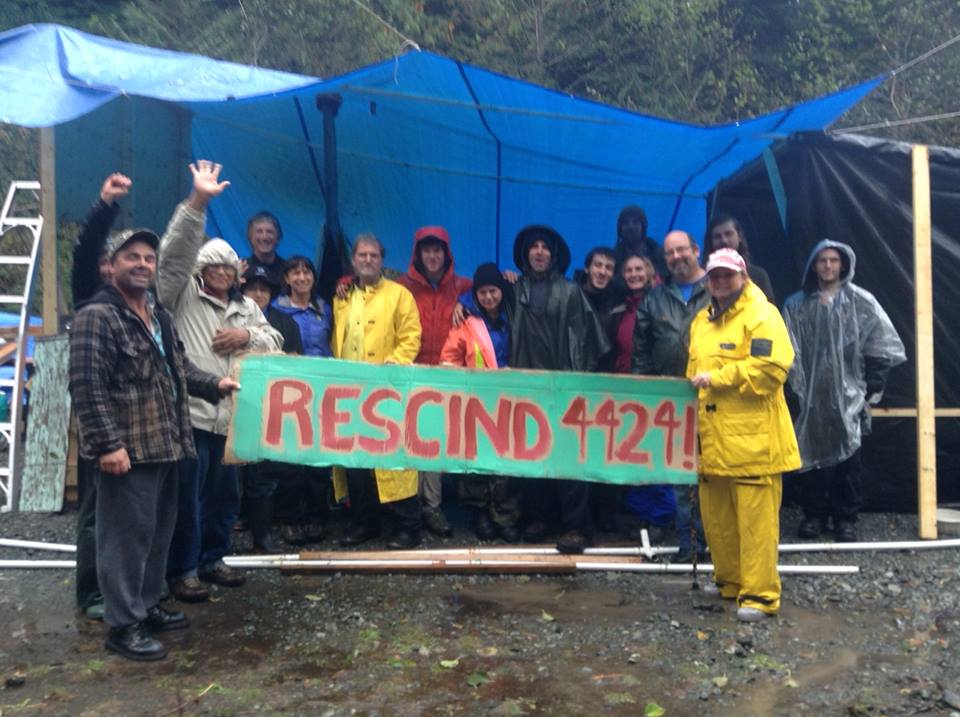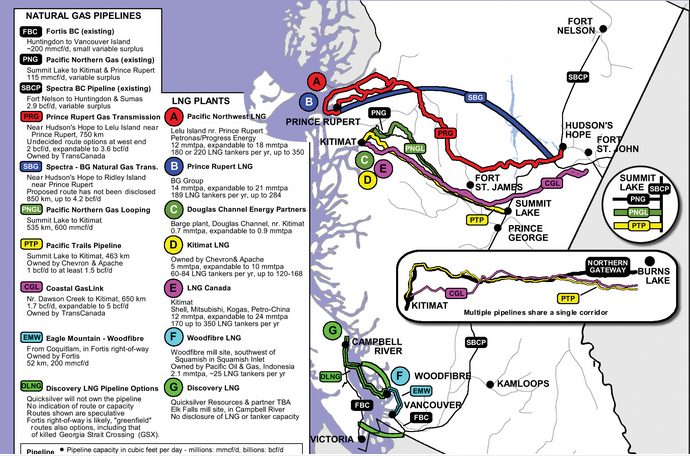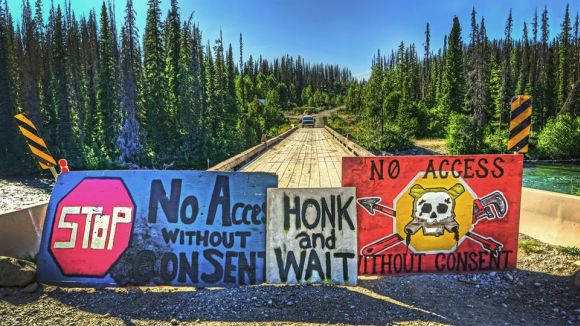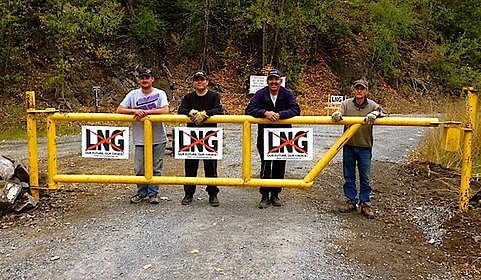
by DGR News Service | Nov 17, 2015 | Biodiversity & Habitat Destruction, Obstruction & Occupation
Bobby Arbess aka Reuben Garbanzo / Friends of Carmanah/Walbran
Sixty years of logging have left only five percent of the primary low-elevation ancient temperate rainforests of Vancouver island remaining. These are some of the world’s most biologically productive forests, attaining higher levels of plant biomass than any ecosystem on earth. The logging industry liquidated the vast majority of these diverse native old-growth forest ecosystems, replacing them with even-aged monoculture tree plantations.
In 1991, 78 days of civil disobedience successfully halted 16 kilometres of scheduled road development through the last, expansive roadless ancient forest wilderness of the Walbran Valley on south Vancouver island. The Road Stops Here campaign combined prolonged tree-sits, road blockades, office occupations, street theatre, dramatic banner hangings, international support and massive public pressure to protect the land a few kilometres upstream from Canada’s iconic Pacific Rim National Park/West Coast Trail. This area is now known as ‘ground zero’ in British Columbia’s ancient forest movement, and a new battle is heating up.
The 16,000 hectare Carmanah/Walbran Provincial Park established in 1994 was a bittersweet victory for environmental activists who fought to save the valley’s ecologically outstanding ancient forests. The park boundaries were drawn up at a roundtable of stakeholders dominated by transnational forest companies owning timber licenses in the valley. The largest and oldest western redcedar trees in the world live at the confluence of three main branches of the watershed, at the heart of the wilderness now known as the Central Walbran Ancient Forest. The 485 hectares north of Walbran river, though designated a “special management zone”, was excluded from full park protection.
Twenty-five years of intense public scrutiny and regulatory provisions have limited “harvesting” to one cutblock in the Central Walbran Ancient Forest. The area is once again the focus of a direct action struggle to keep industrial destruction such as chainsaws, heli-logging and road building out of this wild rainforest of giant trees adjoining the park.
Ongoing road building on steep slopes of the unprotected land-base opens more and more old-growth remnants to clearcut logging. In reaction, there is a growing resurgence of public support, particularly in rural communities, for preserving the unfragmented wilderness of the Ancient Forest. Before a twelve-year government policy of shutting down local unionized mills in favour of raw log exports, the rural communities were based on thriving forestry towns. Now they watch the last massive trees pass their windows on the backs of the same log trucks which exported their livelihoods.
In June 2015, logging company Teal Jones submitted a plan for eight cutblocks in the area. With approval given for a heli-logging operation to high-grade cut a grove of 500-1200 year old trees, logging is now imminent in this pocket wilderness within the traditional Pacheedaht First Nations territory.
There is a slow-growing yet persistent expression of opposition to the logging within the indigenous community, to the chagrin of band council leaders. These leaders maintain a close relationship with the logging company and manage their own logging operations elsewhere in their territory, with plans to build and run a sawmill to generate jobs and revenues.
Many economic alternatives to continued old-growth logging are being proposed to address the high unemployment and poverty in the community:
- ethnocultural forest tourism
- harvesting of non-timber and other traditional forest products such as mushrooms, berries, and basketry materials
- ecologically-managed second growth plantations
- value-added production of finished wood products
- maximizing employment per cubic metre of wood and minimizing impacts on the land, waterways and biological diversity who depend on healthy and old-growth forests for their continued survival
The remaining old-growth forests of the Walbran valley harbor the highest concentrations of the Marbled Murrelet, an endangered seabird, anywhere outside of Alaska. The forests also shelter other old-growth dependent birds including the Western Screech owl, Western Pygmy owl, and Northern Goshawk, all listed by the Committee on the Status of Endangered Wildlife in Canada (COSEWIC) as vulnerable or threatened. Fifteen years of old-growth forest canopy research has revealed hundreds of species found nowhere else in the world, inhabiting suspended soil habitats of the forest canopy. These unique microhabitats are found as much as two hundred feet off the forest floor, and are not supported by second-growth forests.
Climate activists are now pointing out the critical ecological role these old forests play for the whole world in sequestering atmospheric carbon and buffering against runaway climate change.
The provincial government has ignored several requests to protect the area, including a petition card campaign of 6000 signatures presented in the legislature in September.
Activists built a witness camp in mid-September to host a continuous presence of observers watching for the start of logging in approved cutblock 4424. Others recently established a “checkpoint” action camp on a main road into the area. In autonomous actions of non-violent civil disobedience, they have erected sporadic road barricades denying access to logging and road-building crews. Company officials have requested that activists move their camp to allow for preparation of a large landing for loading logs onto trucks. So far the activists have not responded to this request and a confrontation in this area may be imminent.
The activists are calling for people to converge on Vancouver Island to observe, support, or participate in actions; make supporting donations through their website; contact BC residents and politicians; and spread the news of the threats and the resistance. They encourage members of the international community to join the Friends of Carmanah/Walbran Facebook group to stay in the loop of daily developments and to access action updates, relevant links and articles, road instructions, and carpool information.
The Friends of Carmanah/Walbran is a loose-knit community of people around the world sharing the passion, resources and collective action to protect this ancient forest, once and for all.

by DGR Colorado Plateau | Sep 26, 2015 | Direct Action, Strategy & Analysis
By Zoe Blunt, Vancouver Island Community Forest Action Network
In every part of the province, industry is laying waste to huge areas of wilderness – unceded indigenous land – for mining, fracking, oil, and hydroelectric projects. This frenzy of extraction is funneling down to the port cities of the Pacific and west to China.
Prime Minister Harper has stripped away legal options to stop this pillaging by signing a new resource trade agreement with China that trumps Canadian and local laws and indigenous rights. Not even a new government has the power to change this agreement for 31 years.
For mainstream environmental groups (and my lawyers, who were in the middle of a Supreme Court challenge to the trade agreement when Harper pre-empted them), it is a total rout. We are used to losing, but not like this.
The only light on the horizon is the rise of direct resistance. BC’s long history of large-scale grassroots action (and effective covert sabotage) is the foundation of this radical resurgence.
This time it’s different. This time we can write off the Big Greens. Tzeporah Berman, once the face of the Clayoquot Sound civil disobedience protests and now head of the Tar Sands Solutions Project, is publicly proposing that enviros capitulate in the hopes of a slightly greener pipeline apocalypse.
As usual, Berman and her kind are far behind the people they pretend to lead. Public opinion is hardening against pipelines and resource extraction.
But the question hangs over us like smoke from an approaching wildfire. How to stop it? The courts are hogtied. The law has no power. The people have no agency. This government simply brushes them aside and carries on. We get it. We’ve had our faces rubbed in it.
This is activist failure. The phase of the movement when most of the public is already on side, when we have filed all the lawsuits, taken to the streets in every city, overflowed every public hearing, and uttered every threat we can muster – and the end result is they are bulldozing this province from the tarsands straight to the coast.
This is the moment when we can expect activists, especially mainstream enviros, to become demoralized and quit or capitulate. Or delude themselves. Green groups are casting about for a strategy that will allow their donors to maintain false hope in a democratic solution. Some are still trying to raise money for legal challenges that can simply be overruled by the treaty with China.
But small cadres are preparing the second phase of the resistance. Indigenous groups are reclaiming territory and blocking development at remote river crossings, on strategic access roads, and in crucial mountain passes. Urban cells are locking down to gates, vandalizing corporate offices, and organizing street takeovers.
It’s a good start. But now we have to look at how to be effective against powerful adversaries with the full weight of the law and the police on their side. How will we protect the land and each other, when push comes to shove?
The new rules don’t change our strategy to bring down the enemy: kick them in the bottom line. The resource sector will wind tighter as competition to feed China intensifies. Profits are slim enough to start with – made up in volume – and investors are jittery already.
We urge our allies to heed the lessons of history. We don’t win by giving up. Tenacity, flexibility, and diversity of tactics turn back the invaders.
Celebrate the warriors. Raise that banner now, and we’ll find out soon enough who’s with us, and who’s looking to appease our new dictators.

by DGR News Service | Jul 24, 2014 | Indigenous Autonomy, White Supremacy
Photo Credit: David Clow
By Will Falk / Deep Green Resistance
Each night Unist’ot’en Clan spokeswoman, Freda Huson, and her husband Wet’suwet’en hereditary chief Toghestiy fall asleep on their traditional land not knowing whether the Royal Canadian Mounted Police are going to storm their bridge in the depths of night.
Each winter, when Freda and Toghestiy ride their snowmobiles down forestry roads to bring in supplies, to hunt, or to check their traplines, they don’t know whether they will find piles of felled trees maliciously dragged across their paths.
Each time Freda and Toghestiy leave their territory for a few days they don’t know if they will return to find another attack in an old tradition of cowardly arson perpetrated by hostile settlers on Wet’suwet’en territories leaving smoking embers where their cabin once stood.
I ponder this as I sit in a workshop with other settlers during the 6-day Unist’ot’en Action Camp – a series of workshops hosted on the traditional territories of the Unist’ot’en Clan of the Wet’suwet’en Nation to promote strategic planning and co-ordination in the struggle against the spread of fossil fuel pipelines. This particular workshop is designed as a discussion to promote understanding about how settlers can work in better solidarity with indigenous peoples struggling to protect their homes and carrying out their responsibilities to the land.
Most of the ideas discussed revolve around decolonizing our hearts and minds to learn to see the role non-indigenous peoples are playing in the genocidal processes threatening the survival of indigenous peoples. Some of the ideas involve material support for indigenous peoples engaged in front line resistance like the Unist’ot’en. A few even suggest that settlers become physically present next to indigenous peoples on the front lines.
But, I am troubled. We have skipped something. What exactly do we mean by “solidarity?”
***
A common scene from my life as a public defender shows me – a white man in a suit and tie – sitting next to a shackled African, Chicana, or indigenous mother in a courtroom. In front of us sits a judge – an older white man in black robes. Across from us sits the prosecutor – another white man in a suit. Directly behind us, where he is felt more than seen, stands a big white man in the brown uniform of a sheriff’s deputy. He has a gun on one hip, a taser on the other, and the keys to my client’s shackles on a loop on his belt.
My client stares at the judge in a mix of horror and hatred as she is sentenced to prison for stealing from a supermarket to support her children or for lying to a police officer about her name because she had outstanding parking tickets and had to get the kids to school or for punching a cop when the latest in a long list of arbitrary stops by police officers finally caused something inside of her to snap.
As the judge announces how many days in jail my client will be spending, she reaches for my arm with tears in her eyes and asks, “Mr. Falk, won’t you do something?”
I cannot meet her gaze. I tell myself there’s nothing I can do. There’s no argument I can make to sway the judge. There’s no way to stop the sheriff’s deputy behind us from leading my client back down the long concrete tunnel connecting the courthouse and the city jail.
I try to comfort myself. What does she want me to do? Yell at the judge? Tackle the deputy? Spit on the prosecutor for his role in sending this mother to jail?
***
We gathered to sit on wooden benches arranged in a half-circle on a hot and sunny morning during the Unist’ot’en Action Camp to listen to two indigenous men speak about their experiences on the front lines of resistance. Each man had been shot at by police and soldiers, each man had served time in jail, and each man received utter respect from each individual listening.
The first man faced 7,7000 rounds fired by the RCMP at the Gustafsen Lake Stand-off in 1995 when a group of Original Peoples occupied a sacred site on a cattle ranch on unceded Canoe Creek First Nation land because the rancher tried to prevent their ceremonies. For his part at Gustafsen Lake, he was sentenced to five years in prison. During the Oka Crisis in 1990 when the town of Oka, Quebec sought to build a golf course over a Mohawk burial ground, the second man and his comrades blockaded several small British Columbian towns shutting down their local economies. He, too, was convicted and spent time in jail for his actions.
The second man said the blockades were carried out “in solidarity” with the resisters at Oka. This was the only time either of the men mentioned the word “solidarity.” They spoke of supporting resistance, praying for resistance, and helping with ceremonies. But, it was only when engaged in actions where co-resisters placed themselves in similarly dangerous situations that the term “solidarity” was used.
***
I got back from Unist’ot’en Camp earlier this afternoon and checked my email for the first time in days. My inbox was inundated by emails from various list serves proclaiming “Solidarity with Palestine!”
Meanwhile, in Gaza, occupying Israeli bulldozers are demolishing the homes of Palestinian families with suspected ties to Hamas while colonial Israeli bombs are indiscriminately falling on men, women, and children adding to the pile of dead numbered at well over 500 corpses and counting.
“That’s terrible, Will,” you may be thinking. “But what do you want me to do about it?”
Put yourself in Gaza right now. Dig a pit in your back yard, turn your ear anxiously to the sky, and keep the path to your back door clear, so that when you hear the hum of jets overhead you can sprint to your makeshift bomb shelter.
Look down the street for bull-dozers. When you spot one, grab the nearest bag in a panic, shove as much food into it as possible, scramble for some clean underwear, find your toothbrush, and sprint out the door without a look back for the nearest safe space.
Stand over the broken corpses of your children in the pile of dust and ashes that used to be their bedroom. Moan. Weep. Wail. When you wake up for the first time without crying, feel the anger burn through your chest and down your arms into your clinched fists. Ask yourself what you should do next.
Ask yourself: What does solidarity look like?
***
Maybe there really was nothing I could do to stop my clients from being hauled to jail in those courtrooms of my past. Unfortunately, I tried not to think about it too much. Placing myself in that vulnerable of a situation was too scary for me. If I argued too strongly, too fervently the judge could fine me. If I yelled at the prosecutor I could be held in contempt of court. If I spit on him, I certainly would be held in contempt of court. If I tried to stop the deputy, I would be tasered and taken to jail. I might even be shot during the scuffle and killed.
The truth is indigenous and other resisters are being dragged to jail, tasered, and even shot and killed every day on the front lines. And, they’ve been on the front lines for a very long time. I’ve realized that freedom from the vulnerabilities frontline resisters experience is a privilege and the maintenance of this privilege is leaving resisters isolated on front lines around the world.
It is time we understand exactly what solidarity looks like. Solidarity looks like the possibility of prison time. Solidarity looks like facing bullets and bombs. Solidarity looks like risking mental, spiritual, and physical health. Solidarity looks like placing our bodies on the front lines – strong shoulder to strong shoulder – next to our brothers and sisters who are already working so courageously to stop the destruction of the world.
Browse Will Falk’s Unis’tot’en Camp series at the Deep Green Resistance Blog








 “We don’t want any more salmon farm sites in our territory and will be taking a much closer look at this industry,” Joe James Rampanen.
“We don’t want any more salmon farm sites in our territory and will be taking a much closer look at this industry,” Joe James Rampanen.